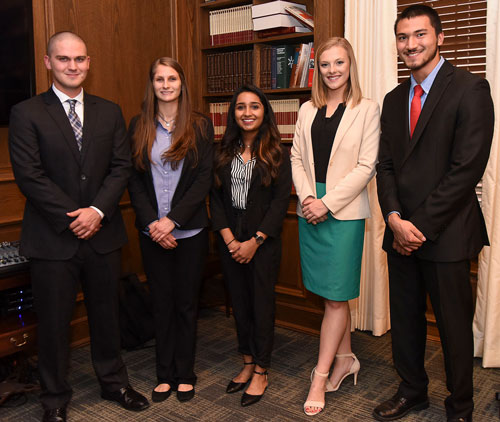Need more information? Contact us
 Recipients of the UAB Presidential Innovation Summer Fellowship program were recognized for their commitment to clinical innovation.Five University of Alabama at Birmingham undergraduate students spent this summer as a part of an interprofessional team working with clinicians to translate ideas into improved patient care and outcomes.
Recipients of the UAB Presidential Innovation Summer Fellowship program were recognized for their commitment to clinical innovation.Five University of Alabama at Birmingham undergraduate students spent this summer as a part of an interprofessional team working with clinicians to translate ideas into improved patient care and outcomes.
Nurses and clinicians chose to devote their lives to patient care, during which they sometimes come across processes or products that could be improved. While they have little time to give to moving a solution to the problem forward, their experience with patients on a daily basis makes them adept at identifying opportunities for improvement.
That is where the student innovators from UAB’s Solution Studios™ come in.
The purpose of UAB Solution Studios™ is to accelerate the translation of clinical innovation by training clinicians and STEM students — those studying science, technology, engineering and math — to collaborate and think creatively around solutions to clinical problems.
Solution Studios™ is a partnership among the UAB Honors College Science and Technology Honors Program, The Office of Interprofessional Curriculum and the UAB schools of Engineering, Medicine and Nursing.
Students who participated in the program this summer were honored Aug. 22 at the end of their time in the UAB Presidential Innovation Summer Fellowship program. The summer 2017 fellowship recipients were Brody DeSilva, Allaire Doussan, Ali El-Husari, Hira Munir and Paige Severino — all Science and Technology Honors Program students in the UAB Honors College.
The program is supported by UAB President Ray L. Watts.
“Collaborations like this make UAB a great place, and this one gives us a special opportunity,” Watts said. “The ability to think as biomedical engineers do with real clinical problems is a very creative and unique situation. As soon as I heard about Solution Studios™, I wanted to make sure we were doing everything possible to support these students and clinicians.”
| “The ability to think as biomedical engineers do with real clinical problems is a very creative and unique situation. As soon as I heard about Solution Studios™, I wanted to make sure we were doing everything possible to support these students and clinicians.” —UAB President Ray Watts |
The students worked in two teams, along with their clinician partners, to address patient-centered problems identified by the clinician. One of the teams worked to create an improved mechanism for attaching wires to a patient.
The second team worked on a novel device aimed to help surgeons create stomas, openings on the surfaces of abdomens to divert the flow of faeces or urine, at specified heights. This will ensure that the stomas empty correctly into ostomy bags, which are medical devices that give the body an avenue to expel waste when it is unable to do so on its own. According to clinician partner Tracie White, who works as an instructor in the School of Nursing and in UAB Hospital’s Division of Gastrointestinal Surgery, there are some critical issues with the current standard of care when it comes to ostomy bags, which makes this a particularly impactful project.
“Many patients have a disease process that results in either a temporary or permanent ostomy,” White said. “These patients have already had a tough time, medically speaking, and now they have to live with a pretty unpleasant device attached to them.”
White heard about the Solution Studios™ concept, and felt compelled to raise ostomy bags as a potential idea for which innovation could play a big role in improving the quality of patient care.
As part of the Solution Studios™ process, the clinician makes a video explaining the problem. Then students log onto the site and select a problem they would like to address.
For teammates El-Husari and Severino, the ostomy bag issue was one they desired to tackle. Once they began their work in the clinical setting, they redirected toward their efforts toward a different solution to the issues that ostomy bags cause, instead focusing on the surgical device to help surgeons on the front end of patients receiving an ostomy bag.
This product could potentially change the standardization of care for patients, according to Jeff Kerby, M.D., Ph.D., director of UAB Hospital's Division of Acute Care Surgery.
“It was truly a great experience to get in an actual clinical setting as an undergraduate student,” Severino said. “I don’t know of any other university that gets its students such innovative opportunities so early on in their careers. UAB is doing that for us, and I couldn’t be more grateful for this program.”
To create a culture of fostering clinical idea generation and testing in academic medical centers, Solution Studios™ implemented structured design thinking into the training of health professionals at UAB. Design thinking is a defined, creative, problem-solving approach that taps into the health professional’s sensibility, coupled with an established practical methodology to meet patient needs through innovations in clinical approaches.
Fundamental to the design thinking strategy is the premise that the successful creation and translation of innovative ideas relies on the ability to empathize with others to understand problems from another’s point of view. From this basis of empathy, potential solutions are realized, quickly prototyped and tested with minimal costs, and then refined through iteration.
From here, the students will continue to work to develop their ideas, with the potential to bring them to market.
“What a great job by both teams. There is no question that this speaks to innovation and to multidisciplinary teamwork," Watts said. "I believe these projects are going to help a lot of people.”